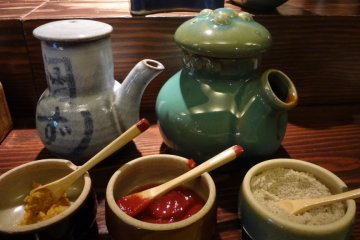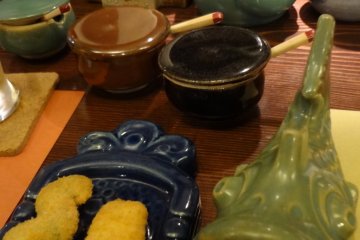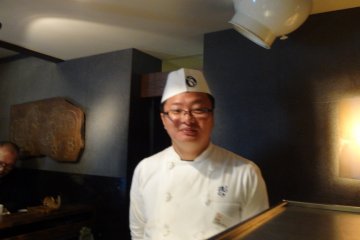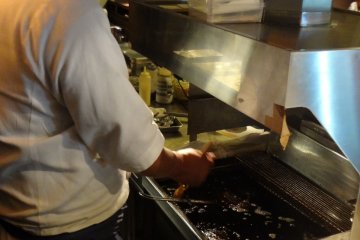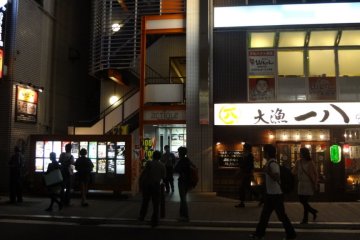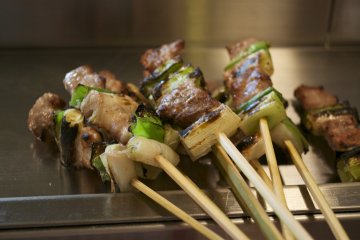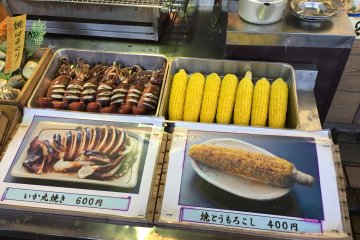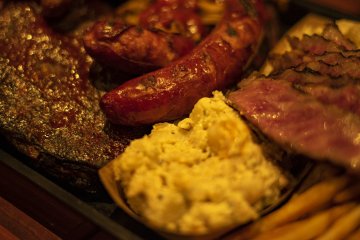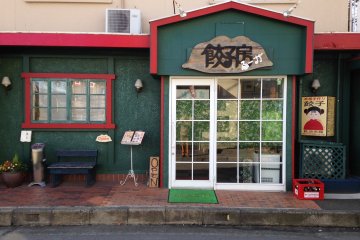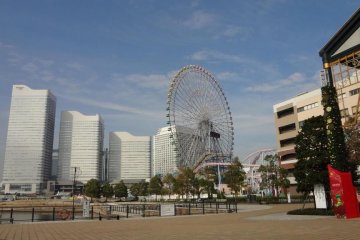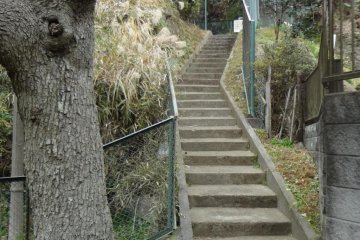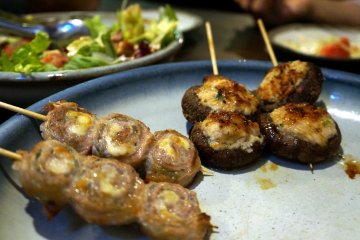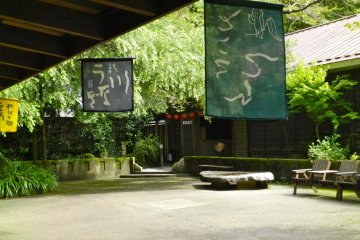What kind of Japanese food do you think of first, when you consider food you would like to try in Japan?
Tempura? Sushi? Sukiyaki? Soba?
Today I will introduce to you a Japanese dish that is quite different from those mentioned above. It is called kushiage. A "kushi" is a skewer, and "a-ge" (ah-geh) means deep fried pork, egg and vegetables. So basically, it is fried food cooked and served on skewers. It is a very easy food to eat; No chopsticks are necessary!
Taking a look at thehistory of this food, originally customers fried their own skewers of food at a counter in stand-and-eat type shops. A big oil pot was heated and placed in front of the customers who had to cook their own. And since, after cooking each skewer, they all also dipped into the same saucepot, there was a strict rule that you could not dip the same skewer into the sauce pot a second time. Only one dip was permitted before you took a bite.
I am happy to tell you that modern type kushiage restaurants have become much more sophisticated.They have clean, comfortable seats, you have your own personal sauce to dip into and you don't need to cook for yourself any more. A chef behind the counter cooks, using some attractive techniques! And after it is freshly fried, you can immediately taste it: Yummy!
Yokohama’s “Ginza Isomura” (銀座磯むら) is a very popular kushiage restaurant. It always gets high scores on restaurant information web sites. They have several shops in Tokyo and Yokohama. Their concept is that ingredients should be fresh and cooked just before the customer eats it. Their interior is “Japanese modern”.
During lunch hours they have three set dishes including 8 to 12 kushiage skewers, as well as rice and miso soup. The price is quite reasonable and the atmosphere casual. Another good point is their “lunch beer”—small glasses of ice-cold beer for only 210 yen each!
At night the restaurant becomes a bit more luxurious. I recommend it to a couple or group who want to have some nice Japanese food but which is not super-expensive, and who would also love to experience the deepness of the world of Japanese sake. Let met tell you about the night I went there with myhusband.
First we ordered a beer on tap. When you order any alcohol, it comes with small side dishes like vegetable sticks. This is a regular feature at most Japanese restaurants or bars. After that we decided to try the "Omakase-Kushi." This means that the chef will keep cooking and serving seasonal kushiage, one by one, until you tell him "Please stop." It costs a minimum of 3500 yen per person. He will keep track of what you've eaten and tell you the price at the end. Or you can tell him what your budget is before you begin! Also, don’t hesitate to let him know if there are any foods you don't want to eat.
Several kinds of dip sauces are prepared and placed on the table. The two big bottles are Worcester sauce and soy sauce with citrus juice mixed in. The three smaller ceramic pots are salt, mustard and ketchup. Before you start to eat, please put these spices in separate areas on your plate.
On that day, the first sticks were mushroom and quail egg. When the chef puts a stick on your dish, he will recommend which type of dip or sauce is a good match for it.
After that, beef fillet, spring onion, a few ginkgo nuts, petit tomato, Pacific saury, matsutake mushroom with chicken, tomato, crab fish, and asparagus with shrimp followed step by step, over a period of about an hour. At this point, we were completely satisfied and completely full. But the chef explained that if we were in the mood for desert, he would serve a nice deep-fried Camembert cheese.
While we talked and ate tasty kushi, we ordered Japanese sake (rice wine) and shouchu (Japanese spirits made from either rice, wheat, black sugar or sweet potatos). If you want some advice for sake or shochu, they will be pleased to make some recommendations. My husband ordered the black sugar shochu on the rocks. It was too strong for me. I enjoyed several types of sake, such as Uragasumi, Hakkaisan, and Dassai. Uragasumi is a seasonal sake. It was fresh and a little bit pungent which is often characteristic of a young sake. Dassai was quite nice and fruity. Compared with the other sakes, it was delicately flavored. I liked it a lot.
When we left the restaurant I thanked the chef for a pleasant night, and asked him a question: "What is kushiage for you?" After he thought a few seconds, he answered: "A variety of tastes, each on its own stick." I agree with him. Please try kushiage during your Yokohama nights!



